A couple of months ago, my son and I had great fun making Pokeweed Ink from the pretty but toxic Pokeweed plant. We made the ink and let it ferment in a dark cabinet and then promptly forgot about it.
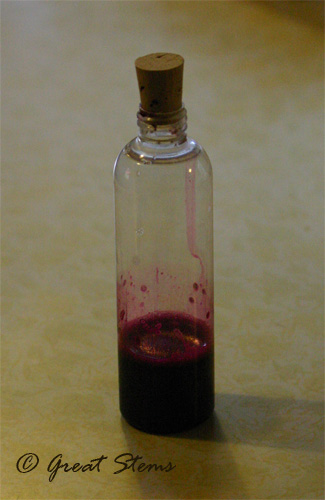 But making the ink proved to be fortuitous, as recently my son was given a Social Studies research project at school — of all the colonies, he ended up with Pennsylvania, the state in which both the Declaration of Independence and the Constitution were written. The rumors around the Internet were that these documents were written in Pokeweed Ink. (Edit: These proved to be inaccurate, however — thanks to Dana R., we know from the National Archives that iron gall ink was actually used. Iron gall ink was the ink of choice for many, many centuries — I’m going to have to experiment again!)
But making the ink proved to be fortuitous, as recently my son was given a Social Studies research project at school — of all the colonies, he ended up with Pennsylvania, the state in which both the Declaration of Independence and the Constitution were written. The rumors around the Internet were that these documents were written in Pokeweed Ink. (Edit: These proved to be inaccurate, however — thanks to Dana R., we know from the National Archives that iron gall ink was actually used. Iron gall ink was the ink of choice for many, many centuries — I’m going to have to experiment again!)
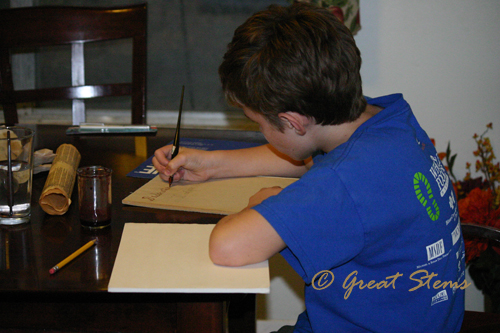 My son’s been working hard on his report and presentation on the Pennsylvania colony, and we remembered that we had that bottle of pokeweed ink, which luckily was still in good shape — apparently it fermented well (in fact, it smelled like either really old grape juice or very, very cheap wine). Whether a historically accurate ink or not, he could use it to create a document of his own.
My son’s been working hard on his report and presentation on the Pennsylvania colony, and we remembered that we had that bottle of pokeweed ink, which luckily was still in good shape — apparently it fermented well (in fact, it smelled like either really old grape juice or very, very cheap wine). Whether a historically accurate ink or not, he could use it to create a document of his own.
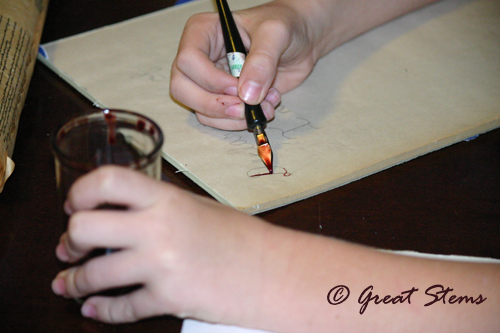 So today we had fun practicing calligraphy with both modern pens and with pen nibs dipped in the pokeweed ink. It’s a lot harder than it looks, using a nib dipped in ink — a modern calligraphy pen is so much easier, alas. But it’s not as cool as using ink the old-fashioned way! However, for this particular project, we realized that doing any fancy writing wasn’t really going to work, so my son stuck with cursive writing.
So today we had fun practicing calligraphy with both modern pens and with pen nibs dipped in the pokeweed ink. It’s a lot harder than it looks, using a nib dipped in ink — a modern calligraphy pen is so much easier, alas. But it’s not as cool as using ink the old-fashioned way! However, for this particular project, we realized that doing any fancy writing wasn’t really going to work, so my son stuck with cursive writing.
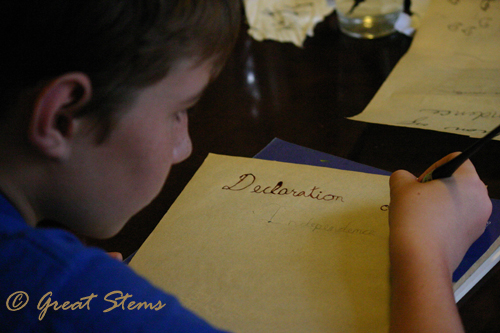 My son prepared a sample Declaration for his presentation. He also took the bottle of ink with him to school. Science, history, art, fun!
My son prepared a sample Declaration for his presentation. He also took the bottle of ink with him to school. Science, history, art, fun!
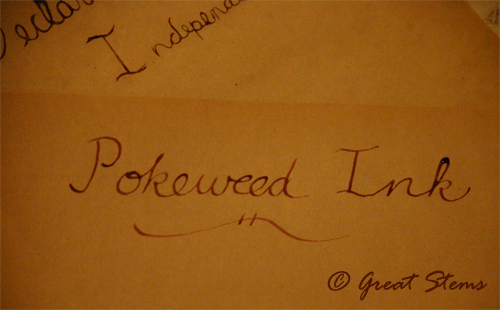
What’s pretty neat, too, is that as the ink dries, the color darkens from the reddish look in the “Pokeweed Ink” text above to the darker in shown in the writing in the corner. Nifty, nifty!
Meredith,
Great to start a monday learning about history. Never knew such famous docs were written in pokeweed ink. Very cool!
I just love connections like these — having Pokeweed berries and learning about their historical uses, then actually recreating the projects. My family has learned so much!
What a wonderful way to bring history into the present. I had a pokeweed plant again this year. I cut it right back and it re sprouted. The frost did away with it this week-or did it. I guess the ink is very long lasting, rather like the stains the mockingbird made from eating the berries!
I always think its very inspiring to find a way to connect to the past like that. I think that is why people love to garden.
This is so cool! I always used pokeweed ink as a child (but I didn’t know about the fermenting process — I used it fresh off the plant). I tended to ink up my fingers more than whatever I was trying to draw on. Sometimes I dyed entire objects, usually rocks. I was so excited to read that it was the ink used on the Declaration & Constitution! My daughter (who is also well-versed in pokeweed usage) will be very impressed.
That’s a great idea about the rocks, Eliza. I’ll give it a try — we’ve been wanting to make our own Petroglyphs, so perhaps I can figure out a way to make a longterm rock stain.
The kids at our last event “Pioneer Paddle at Shingle Creek” here in Florida used our native plant inks which included Pokeberry. The girls were particularly fond of the bright pink color. All the kids learned how tough it must have been trying to do your homework as a pioneer child. We gave them quills to use that were found around our yards. The most fun part was seeing the adults watching the kids and then we would ask if they would like to make a bookmark. Quite a few were pleased to be asked and jumped “write” in.
To preserve our inks we added a teaspoon of vinegar and a teaspoon of salt. I have blackberry ink that I made in May that is still going strong.
I ended up adding a little vinegar the other day, too, so I’m glad to hear it’s something you also use. I didn’t know about the salt — I’ll have to look into that. Sounds like your pioneer event was an incredible success!
If Pokeweed is poisinous how can the mocking birds eat the berries?
Joe, birds can handle many kinds of berries that humans and other mammals can’t. Poisons that might make us ill or kill us might have no effect at all on birds. This helps them disperse the seeds for the plants — their bodies digest the fruit, or “meat,” and then they poop out the seeds, which can then germinate in the new patch of soil, wherever that may be. Thanks for stopping by!